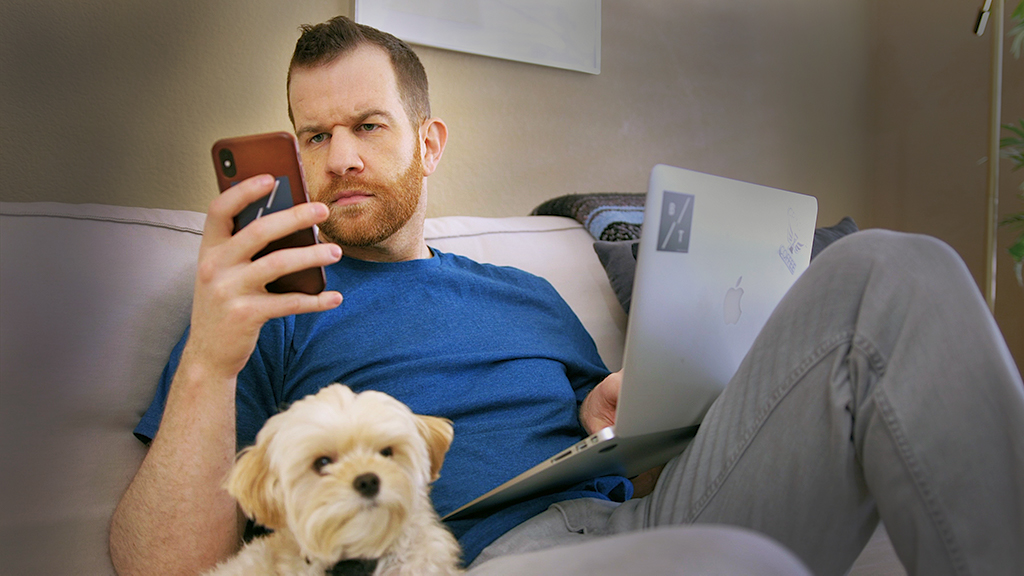
Have you ever picked up your phone and the next thing you know, 30 minutes have passed? Or perhaps, purchased something you didn’t really need with just one click through your favorite shopping app? Maybe you’ve sat down at the computer to work—only to spend the first 20 minutes on Facebook.
If these situations sound familiar, you’re not alone. If you’re like most Break the Twitch readers, you’ve recognized these tiny distractions and are working to change them. There’s a simple concept I’ve used over the last five years that’s helped with these distractions.
I call it intentional friction, and it’s a total game-changer if you’re trying to improve your focus and get less distracted day-to-day.
Five years ago, I was at my desk writing a blog post as the Marketing Director of a nonprofit. A coworker came by my office, interrupted me, and what happened next literally changed my life forever.
I looked over, mid-keystroke. When I looked back, I had written the word facebook right in the middle of my sentence. Subconsciously, I had tried to go to Facebook.com and failed… because I typed it into a Word document.
This incident opened my eyes to just how deeply these types of distractions were rooted in my brain. I began working to recognize and explore solutions for the areas in my life where I tended to “Twitch.”
In practice, intentional friction is a very simple concept.
Intentional friction is adding more difficulty around an easy action you want to do less of, so you have more space to make a conscious choice.
As our devices become more integrated into our lives, it has become increasingly easier to do the unintentional things that steal our attention. These conveniences are designed, using research from behavioral scientists that allow attention thieves to capture as much attention as possible.
When our time is being stolen in these spare moments, we don’t fully own our attention. And when we don’t fully own our attention, we’re not directing it towards the things that truly matter to us.
And that’s a problem.
It’s not that all technology and devices are bad for us; it’s only a problem because most of these consumer devices are not designed to be used in a balanced way. For most companies, attention is money, and if they don’t have your attention, they’re not making money.
It can be difficult or near impossible to completely remove all distractions from your life. This is especially true if your work relies on social media or relative connectivity. But even so, there are very effective ways to reduce the impact of these distractions.
Intentional friction has helped me better own my attention and spend my time more intentionally.
Designing our environment with intentional friction is a great way to better manage our attention—especially with smartphones and other frequently used devices.
I’ve used intentional friction to reduce the time I spend on my phone, exercise more, eat healthier, and maintain my minimalism habit. If you’re struggling with building habits, it’s likely not a motivation problem—it’s a friction problem.
Here are some ideas for creating intentional friction in your life.
If there’s an app you find yourself spending too much time on, relocate the icon away from the main screen. Take it a step further and bury it in a folder so you don’t even see the icon at all.
You could also log yourself out and set up a long password you would need to enter in whenever you wanted to use the app. Another option is to delete an app off your phone entirely (as I’ve done before with Facebook and the default browser).
Adding a few extra steps prevents you from quickly “twitching,” and using the app mindlessly in those in-between moments. The intentional friction provides you a little more time so you can consider if you really want to use a certain app.
Years ago, I set a screen-time limit on my iPhone and had a friend set up a passcode that he only knew. Extreme? Perhaps—but it worked.
To minimize phone use before bed, I’ve charged my phone outside the bedroom. You can literally design whatever intentional friction you need, so it’s important to experiment and see what creates the best results for you.
Another example I’ve mentioned before is if you want to use fewer paper towels, you can put a rubber band around it. In this case, your automatic instinct to grab a paper towel is interrupted—giving you a moment to pause, consider, and then make a more conscious choice.
Similarly, you can use the concept in reverse—reducing unintentional friction.
Reducing unintentional friction and increasing intentional readiness can help encourage the actions you want to do more of by making them easier to choose.
Reduce unintentional friction around exercising more by having your gym clothes and shoes prepared and accessible the night before.
Another example is having healthy food and snacks in the house, so that’s the only option when you’re at home. If you want to read more, you can put a book right by your bedside table (and charge your phone outside of the bedroom).
There are many ways you can create intentional friction (or reduce unintentional friction) to make small but impactful changes in your life. I’ve personally found great success in implementing this in my own life, and I’d encourage you to give it a try.
